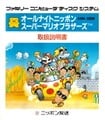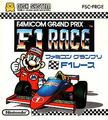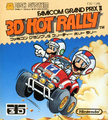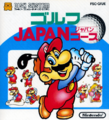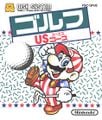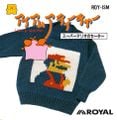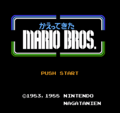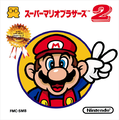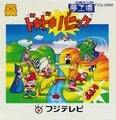Family Computer Disk System
The Family Computer Disk System (also called the Famicom Disk System) is an accessory for the Family Computer. It allowed the Family Computer to play certain games on a proprietary floppy disk format called "Disk Cards" rather than ROM cartridges. Disk Cards had the advantages of being cheaper and allowing for higher data capacity than cartridges at the time. Besides that, the disks were rewritable, making saving easier. Nintendo sought to make Disk Cards a permanent standard for all of their future games at that point, though this plan was abandoned a few years later, due to various issues. Sharp Corporation, a Japanese Electronics and Domestic Appliance company, created the Twin Famicom, a Family Computer combined with the Disk System into one piece of hardware, but it was also only released in Japan.
Issues
The main reason why Family Computer Disk System was not released outside Japan and why it eventually lost developer support altogether is believed to be due to a lack of success caused by various issues with the system:[1]
- The games were significantly easier to pirate; the way the Disk System recognized pirated games was by checking to see if the "I" and the third "N" embossed "NINTENDO" logo at the bottom of a Disk Card was present, via fitting a raised version of the same logo into the embossing. The intention behind this was for Nintendo to be able to directly counter production of unauthorized Disk Drive games by suing their manufacturers for trademark infringement, assuming that pirates would copy the full logo outright. However, it was easy for pirates to bypass this check without directly copying Nintendo's logo by creating alternate off-brand logos with the "I" and third "N" intact (i.e. "NINFENDO" or "NINIENDO") or by simply embossing blank spaces that occupied the locations of the necessary letters. Furthermore, the fact that Disk Cards were simply modified versions of Quick Disks (a brand of floppy disk easily purchasable in stores in the late 1980's) meant that unauthorized Disk Cards could be easily manufactured by attaching a copy check-compatible piece of plastic to the bottom of a Quick Disk.
- The games were easier to damage; Disk Cards, being a form of magnetic media, were sensitive to magnetic wavelengths, and unlike regular 3.5-inch floppy disks, most Disk Cards did not include a shutter to protect the window that exposed the magnetic disk inside; shutters were only included on blue competition cards and gold prize cards. The lack of a shutter meant that the disk could get scratched, dirty, or even grow mold in severe cases.
- The system itself was more fragile than the base Famicom, due to the large number of moving parts needed for the disk drive; in particular, the rubber belt that the system used was prone to wearing down much faster than that of a standard floppy disk drive.
- Any games that made use of the supplementary audio channel provided by the Disk System's 2C33 chip would have to be drastically altered during localization for international markets to conform to the audio capabilities of the standalone Famicom, as no devices were released for the Nintendo Entertainment System that supported 2C33 chip audio.
- The games had lengthy loading times at various points (often when swapping sides, or when entering particularly data-heavy areas). This is because magnetic disk drives have to physically seek out where data is located on the disk in order to load it into RAM. By comparison, cartridges are able to load near-instantaneously due to all the data being stored in a single location, that being the on-board ROM chip.
- Most games would have to be split across both sides of the Disk Card due to the small size of the magnetic disks; typically, the first and final portions of the game would be stored on Side A, while the rest would be stored on Side B. Consequently, whenever the player progressed to a certain point in a game, they would be required to eject and flip the Disk Card before reinserting it.
- The jewel cases that contained the games were smaller than cartridge boxes, and were therefore easier to overlook in stores or lose in homes. The cases were also required to fully protect the Disk Card, whereas cartridges could be stored, standalone, on shelves.
- The technological superiority of the Disk Card format was short-lived, with higher-capacity cartridges becoming cheaper to produce just a few years later. Combined with the higher rate of piracy that Disk Cards suffered from, this deprived the format of the practicality that served as its primary selling point for developers.
The piracy issue was an especially big problem for Nintendo, and is believed to be the source of their stringent policies regarding copyright protection. It is also widely believed that the Disk System's high piracy rate is what convinced Nintendo to use cartridges for the Nintendo 64 rather than the technologically superior optical discs seen in their rivals, the Sega Saturn and Sony PlayStation.
In 1986, Nintendo sought to counter Disk System piracy by installing special Disk Writer kiosks that would allow consumers to download games onto Disk Card for ¥500 as opposed to the retail price of ¥2,600; some Disk System games were even exclusive to these kiosks. The service was very popular, remaining in place until the Family Computer line's discontinuation in 2003, 9 years after the discontinuation of the Disk System itself.
Games
| Title | Release date | Publisher(s) | Serial Number | Notes |
|---|---|---|---|---|
| 19 - Neunzehn | 1988-03-04 | Soft Pro | SFC-NEU | |
| Adian no Tsue | 1986-12-12 | Sunsoft | SSD-ADA | |
| Ai Senshi Nicol | 1987-04-24 | Konami | KDS-AIN | |
| Akumajōu Dracula | 1986-09-26 | Konami | KDS-AKM | Later released for the NES and the Famicom as Castlevania |
| Akū Senki Raijin | 1988-07-12 | Microcabin | SQF-RJN | |
| All Night Nippon Super Mario Bros. | 1986-12 | Fuji TV | ANN-NSM | Given away in a contest by the Japanese radio program All Night Nippon |
| All One | 1991-02-22 | Tokuma Shoten | GTS-ALD | Famimaga Disk Vol. 3 |
| Apple Town Story | 1987-04-03 | Square | SQF-APT | |
| The Miracle of Almana | 1987-08-11 | Konami | KDS-ARM | |
| Aspic - Majaō no Noroi | 1988-03-31 | Bothtec | BTC-ASP | |
| Backgammon | 1990-09-07 | Nintendo | FMC-BAG | |
| Bakutōshi Patton-Kun | 1988-08-05 | Soft Pro | SFC-PAT | |
| Baseball | 1986-02-21 | Nintendo | FMC-BAS | Originally released for the Famicom and the NES |
| Big Challenge! Dogfight Spirit | 1988-10-21 | Jaleco | JDF-DFS | |
| Big Challenge! Go! Go! Bowling | 1989-06-23 | Jaleco | JDF-GGB | |
| Big Challenge! Gun Fighter | 1989-03-28 | Jaleco | JFD-GNF No.09 | |
| Big Challenge! Judo Senshuken | 1988-08-10 | Jaleco | JFD-CJS No.06 | |
| Bio Miracle-I'm Upa | 1988-04-22 | Konami | KDS-BOK | Later released for the Famicom |
| Bomberman | 1990-04-24 | Hudson Soft | HFC-BMD | Originally released for the Famicom and the NES |
| Breeder | 1986-12-15 | Soft Pro | SFC-BRE | |
| Bubble Bobble | 1987-10-30 | Taito | TFD-BUB | Later released for the NES |
| BurgerTime | 1988-09-23 | Data East | DFC-BGT | Originally released for the Famicom and the NES |
| Chitei Tairiku Ordola | 1987-03-27 | Sunsoft | SSD-ORD | |
| Cursed Treasure of Cleopatra | 1987-07-24 | Square | SQF-CLO | |
| Clox | 1991-04-19 | Tokuma Shoten | GTS-CKD | Famimaga Disk Vol. 4 |
| Clu Clu Land: Welcome to New Clu Clu Land | 1992-04-28 | Nintendo | FMC-CLD | |
| Cocona World | 1987-04-10 | SOFEL | SFL-CCN | |
| Dandy: Zeuon No Fukkatsu | 1988-10-21 | Pony Canyon | PNF-DAN | |
| Dead Zone | 1986-11-20 | Sunsoft | SSD-DZN | |
| Deep Dungeon | 1986-12-19 | HummingBirdSoft | SQF-DPD | |
| Dig Dug | 1990-07-20 | Namco | NDS-DIG | Originally released for the Famicom |
| Dig Dug II | 1990-08-31 | Namco | NDS-DD2 | Originally released for the Famicom and the NES |
| Dirty Pair: Project Eden | 1987-03-28 | Bandai | BAN-DPR | |
| Donkey Kong | 1988-04-08 | Nintendo | FMC-DKD | Originally released for the Famicom and the NES |
| Donkey Kong Jr. | 1988-07-19 | Nintendo | FMC-JRD | Originally released for the Famicom and the NES |
| Doremikko | 1987-12-04 | Konami | KDS-DRE RJ250 |
|
| Dr. Chaos | 1987-06-19 | Pony Canyon | PNF-DRC | Later released for the NES |
| Dracula II: Noroi no Fūin | 1987-08-28 | Konami | KDS-DRK | Later released for the NES as Castlevania II: Simon's Quest |
| Druid: Kyōfu no Tobira | 1988-03-03 | Jaleco | JFD-DRD | |
| Eggerland | 1987-01-29 | HAL Laboratory | HAL-EGL | |
| Eggerland – Departure to Creation | 1988-08-20 | HAL Laboratory | HAL-EGS | |
| Electrician | 1986-12-26 | Kemco | KSC-ELC | |
| Esper Dream | 1987-02-20 | Konami | KDS-ESP | |
| Exciting Baseball | 1987-12-08 | Konami | KDS-EBS | |
| Exciting Basketball | 1987-07-24 | Konami | KDS-EKB | Later released for the NES as Double Dribble |
| Exciting Billiard | 1987-06-26 | Konami | KDS-EKS | |
| Exciting Soccer: Konami Cup | 1988-02-16 | Konami | KDS-ESC | |
| Fairytale | 1989-04-28 | Soft Pro | SFC-FYT | |
| Falsion | 1987-10-21 | Konami | KDS-FAL | Compatible with 3D Glasses |
| Famicom Grand Prix: F-1 Race | 1987-10-30 | Nintendo | FSC-FRGE | |
| Famicom Grand Prix II: 3D Hot Rally | 1988-04-14 | Nintendo | FSC-TDRE | |
| Famicom Detective Club: The Missing Heir (first part) | 1988-04-27 | Nintendo | FMC-TC1 | |
| Famicom Detective Club: The Missing Heir (second part) | 1988-06-14 | Nintendo | FMC-TC2 | |
| Famicom Detective Club Part II: The Girl who Stands Behind (first part) | 1989-05-23 | Nintendo | FMC-TC3 | Later remade for the Super Famicom |
| Famicom Detective Club Part II: The Girl who Stands Behind (second part) | 1989-06-30 | Nintendo | FMC-TC4 | Later remade for the Super Famicom |
| Family Composer | 1987-10-30 | Tokyo Shoseki | TKS-FCO | |
| Family Computer Othello | 1986-11-13 | Kawada | KWD-OTH | Also released for the Famicom and later released for the NES |
| Final Command: The Red Fortress | 1988-05-02 | Konami | KDS-AKA | Later released for the NES as Jackal with some changes |
| Fire Bam | 1988-02-01 | HAL Laboratory | HAL-FBM | |
| Fire Rock | 1988-06-20 | System Sacom | USE-FRC | |
| Fūun Shōrin Ken | 1987-04-17 | Jaleco | JFD-FSH | |
| Fūun Shōrin Ken: Ankoku no Maō | 1988-04-22 | Jaleco | JFD-SAM | |
| Gall Force: Eternal Story | 1986-12-10 | HAL Laboratory | HAL-GAL | |
| Galaga | 1990-06-22 | Namco | NDS-GAG | Originally released for the Famicom and the NES |
| Galaxian | 1990-07-20 | Namco | NDS-GXN | Originally released for the Famicom |
| German Tanteidan: Marine-gumi Jaaman Tanteidan: Matonarikumi Jaaman Tanteidan Marine Kumi: Maruhi Jigoma Sousa File | 1988-11-29 | Bandai | BAN-MAR | |
| Ginga Denshō: Galaxy Odyssey | 1986-11-06 | Imagineer | IMA-GIN | |
| Gokuraku Yūgi: Game Tengoku | 1987-12-12 | SOFEL | SFL-GTG | |
| Golf | 1986-02-21 | Nintendo | FMC-GLF | Originally released for the Famicom and the NES |
| Golf Japan Course | 1987-02-21 | Nintendo | FSC-GFJE | |
| Golf U.S. Course | 1987-06-14 | Nintendo | FSC-GFUE | |
| The Goonies | 1988-04-08 | Konami | KDS-GNS | Originally released for the Famicom |
| Green Beret | 1987-04-10 | Konami | KDS-GRN | Later released for the NES as Rush'n Attack |
| Gun.Smoke | 1988-01-27 | Capcom | CAP-GUN | Also released for the NES |
| Gyruss | 1988-11-18 | Konami | KDS-GRS | Later released for the NES |
| Halley Wars | 1989-01-14 | Taito | TFD-HAL | |
| Hao's Mysterious Journey | 1987-05-01 | DOG | SQF-HFT | Later released for the NES as Mystery Quest, although the levels are completely different |
| Hikari Genji: Roller Panic | 1989-03-20 | Pony Canyon | PNF-GEN (L32V5920) | |
| Hikari Shinwa: Palthena no Kagami | 1986-12-19 | Nintendo | FMC-PTM | Later released for the NES as Kid Icarus |
| Hong Kong | 1990-03-23 | Tokuma Shoten | GTS-HKD | Famimaga Disk Vol. 1 |
| I am a Teacher: Super Mario no Sweater | 1986-08-27 | Royal Kougyou | ROY-ISM | [2] |
| I am a Teacher: Teami no Kiso | 1986-09-26 | Royal Kougyou | ROY-ITK | |
| Ice Climber | 1988-11-18 | Nintendo | FMC-ICD | Originally released for the Famicom and the NES, although this version is a port of Vs. Ice Climber |
| Ice Hockey | 1988-01-21 | Nintendo | FMC-ICE | Later released for the NES |
| Igo: Kyū Roban Taikyoku | 1987-04-14 | BPS | BPS-IGO | Also released for the Famicom |
| Ishido: The Way of Stones | 1990-12-07 | Hiro | HIR-ISD | |
| Janken Disk Jō | 1992-12-22 | Tokuma Shoten | GTS-JKD | Famimaga Disk Vol. 6[3] |
| Jikai Shounen Mettomag | 1987-07-03 | DOG | SQF-MTM | |
| The Return of Mario Bros. | 1988-11-30 | Nintendo | FMC-KMAR | Disk writer only game[4] |
| Kamen Rider Black: Taiketsu Shadow Moon | 1988-04-15 | Bandai | BAN-BLA | |
| Karate Champ | 1988-07-22 | Data East | DFC-KAR | Originally released for the NES |
| Kattobi! Dōji | 1989-10-20 | Pack-In-Video | PAC-KTD | |
| Kick and Run | 1988-09-13 | Taito | TFD-KIC | |
| Kick Challenger: Air Foot | 1987-11-20 | VAP | VAP-AFT (9502) | |
| Kidō Keisatsu Patlabor | 1989-01-24 | Bandai | BAN-PTL | |
| Kiki Kaikai: Dotō Hen | 1987-08-28 | Taito | TFD-KIK | Precedes the Pocky & Rocky series |
| Kieta Princess | 1986-12-20 | Imagineer | IMA-KIE | |
| Kinnikuman: Kinniku-Sei Ōi Sōdatsusen | 1987-05-01 | Bandai | BAN-KNM | |
| Knight Lore | 1986-12-19 | Jaleco | JFD-KLM | |
| Knight Move | 1990-06-05 | Nintendo | FMC-KMV | |
| Konami Ice Hockey | 1988-07-22 | Konami | KDS-HOC | Later released for the NES as Blades of Steel |
| Konami Tennis | 1988-08-19 | Konami | KDS-TNI | |
| A Kitten's Story: The Adventures of Chatran | 1986-09-19 | Pony Canyon | PNF-KOM (L29V5904) | |
| The Legend of Zelda | 1986-02-21 | Nintendo | FMC-ZEL | Later released for the NES and the Famicom |
| The Legend of Zelda 2: The Adventure of Link | 1987-01-14 | Nintendo | FMC-LNK | Later released for the NES as Zelda II: The Adventure of Link |
| Lutter | 1989-11-24 | Athena | ATH-LTD | |
| Magma Project: Hacker | 1989-08-10 | Tokuma Shoten | GTS-MPH | |
| Mahjong | 1986-02-21 | Nintendo | FMC-MJA | Originally released for the Famicom |
| Mahjong Kazoku | 1987-08-04 | Irem | IFD-MJK | |
| Märchen Veil | 1987-03-03 | Sunsoft | SSD-MVL | |
| Matō no Hōkai: The Hero of Babel | 1988-09-02 | Pony Canyon | PNF-MAT (L30V5918) | |
| Meikyū Jiin Dababa | 1987-05-29 | Konami | KDS-MIK | |
| Metroid | 1986-08-06 | Nintendo | FMC-MET | Later released for the NES |
| Michael English Daibōken | 1987-06-19 | Scorpion Soft | SCO-MEA | |
| Moero Twinbee: Cinnamon Hakase wo Sukue! | 1986-11-21 | Konami | KDS-TIN | Later released for the NES as Stinger and the Famicom, the 3-player mode was cut from the NES version |
| Monitor Puzzle, The: Kineco - Kinetic Connection | 1986-11-28 | Irem | IFD-KIN | |
| Monitor Puzzle, The: Kineco Vol. II - Kinetic Connection | 1987-05-01 | Irem | IFD-KI2 | |
| Monty no Doki Doki Daisassō: Monty on the Run | 1987-07-31 | Jaleco | JFD-MDD | [2] |
| Moonball Magic | 1988-07-12 | Square | SQF-MBM | |
| Mr. Gold: Tōyama no Kinsan in Space | 1988-07-19 | Toei | TDF-MRG | |
| Nakayama Miho no Tokimeki High School | 1987-12-01 | Nintendo | FSC-THSE | Features the likeness of Japanese singer, model, and actress Miho Nakayama. |
| Namida no Sōkoban Special | 1986-07-30 | ASCII Corporation | ASC-001 | Later released for the American TurboGrafx-16 as Boxy Boy with improved graphics |
| Nanking no Adventure | 1988-12-09 | Sunsoft | SSD-NAD | |
| Nazo no Kabe: Block Kuzushi | 1986-12-13 | Konami | KDS-NZN | Later released for the NES as Crackout (PAL-exclusive) |
| Nazo no Murasame Jō | 1986-04-14 | Nintendo | FMC-NMJ | |
| Nazoler Land | 1987-02-06 | Sunsoft | SSD-NZL | |
| Nazoler Land Dai 2 Gō | 1987-06-12 | Sunsoft | SSD-NZB | |
| Nazoler Land Dai 3 Gō | 1988-03-11 | Sunsoft | SSD-NZC | |
| Nazoler Land Special | 1987-12-18 | Sunsoft | SSD-NSP | |
| Omoikkiri Tanteidan Haado Gumi: Matenrō no Chōsenjō | 1988-03-25 | Bandai | BAN-HRD | |
| Otocky | 1987-03-27 | SEDIC | ASC-OTO | |
| Pac-Man | 1990-05-18 | Namco | NDS-PAC | Originally released for the Famicom and the NES |
| Pachicom | 1988-10-04 | Toshiba EMI | TFS-PCD | Originally released for the Famicom |
| Pachinko Grand Prix | 1988-11-18 | Data East | DFC-PGP | |
| Panic Space | 1990-10-19 | Tokuma Shoten | GTS-PSD | Famimaga Disk Vol. 2 |
| Pinball | 1989-05-30 | Nintendo | FMC-PND | Originally released for the Famicom and the NES |
| Pro Golfer Saru: Kage no Tournament | 1987-05-25 | Bandai | BAN-PGS | |
| Professional Mahjong Goku | 1986-12-25 | ASCII Entertainment | ASC-GKU | |
| Pulsar no Hikari: Space Wars Simulation | 1987-10-02 | Soft Pro | SFC-PSR | |
| Pro Wrestling: Famicom Wrestling Association | 1986-10-21 | Nintendo | FMC-PRO | Later released for the NES as Pro Wrestling |
| Putt Putt Golf | 1989-03-30 | Pack-In-Video | PAC-PPG | |
| Puyo Puyo | 1991-10-25 | Tokuma Shoten | GTS-PYO | Famimaga Disk Vol. 5, Later released for the Famicom |
| Puzzle Boys | 1990-11-16 | Atlus | ATL-PUZ | |
| Radical Bomber!! Jirai Kun | 1988-07-29 | Jaleco | JFD-GRK | |
| Reflect World | 1987-06-02 | East Cube | ECF-RWD | |
| Relics: Ankoku Yōsai | 1987-04-10 | Bothtec | BTC-RLC | |
| Replicart | 1988-02-26 | Taito | TFD-REP-3500 | Released in pencil-pouch case. |
| Risa no Yōsei Densetsu: Risa Tachibana | 1988-06-21 | Konami | KDS-YOU | Features the likeness of Japanese idol Risa Tachibana. |
| Roger Rabbit | 1989-02-16 | Kemco | KSC-RRR | Later released for the NES as The Bugs Bunny Crazy Castle with cosmetic changes |
| Samurai Sword | 1988-11-15 | Capcom | CAP-SMU | |
| Santa Claus no Takarabako | 1987-12-04 | Data East | DFC-SAN | |
| SD Gundam World: Gachapon Senshi - Scramble Wars | 1988-01-20 | Bandai | BAN-SGW | |
| SD Gundam World: Gachapon Senshi - Scramble Wars Map Collection | 1989-03-03 | Bandai | BAN-SG2 | |
| Section Z | 1987-05-25 | Capcom | CAP-SCZ | Later released for the NES |
| Seiken: Psycho Calibur | 1987-05-19 | Imagineer | IMA-MAJ | |
| Shin Onigashima (Disk 1) | 1987-09-04 | Nintendo | FMC-ON1 | Also known as Famicom Mukashibanashi: Shin Onigashima |
| Shin Onigashima (Disk 2) | 1987-09-30 | Nintendo | FMC-ON2 | Also known as Famicom Mukashibanashi: Shin Onigashima |
| Smash Ping Pong | 1987-05-30 | Nintendo | FMC-PPN | Later released on the Virtual Console as Smash Table Tennis |
| Soccer | 1986-02-21 | Nintendo | FMC-SCC | Originally released for the Famicom and the NES |
| Solomon no Kagi | 1991-01-25 | Tecmo | TCF-SKD | Originally released for the Famicom and the NES as Solomon's Key |
| Suishō no Dragon | 1986-12-15 | Square | SQF-SSD | |
| Super Boy Allan | 1987-03-27 | Sunsoft | SSD-ALN | |
| Super Lode Runner | 1987-03-05 | Irem | IFD-SLR | |
| Super Lode Runner II | 1987-08-25 | Irem | IFD-SL2 | |
| Super Mario Bros. | 1986-02-21 | Nintendo | FMC-SMA | Originally released for the Famicom and the NES |
| Super Mario Bros. 2 | 1986-06-03 | Nintendo | FMC-SMB | Later released for the SNES as part of a compilation in Super Mario All-Stars, it was retitled as Super Mario Bros.: The Lost Levels |
| Sword of Kalin | 1987-10-02 | DOG | SQF-KRN | |
| Silviana | 1988-08-10 | Pack-In-Video | PAC-SIL | |
| Tama & Friends: Great 3rd Street Adventure | 1989-02-23 | Bandai | BAN-UTM | |
| Tanigawa Kōji no Shōgi Shinan II | 1987-11-13 | Pony Canyon | PNF-SHO | Later released for the Famicom |
| Tanigawa Kōji no Shōgi Shinan II - Shinban | 1988-08-10 | Pony Canyon | PNF-SH2 | Purchase method was special, only by sending a disk card to Nintendo head office and branch office, could one buy it by rewriting |
| Tantei Jingūji Saburo: Kiken na Ninin (first part) | 1988-12-09 | Data East | DFC-KF1 | |
| Tantei Jingūji Saburo: Kiken na Ninin (second part) | 1989-02-10 | Data East | DFC-KF2 | |
| Tantei Jingūji Saburo: Shinjuku Chūō Kōen Satsujin Jiken | 1987-04-24 | Data East | DFC-JUK | |
| Tarot | 1988-12-23 | Scorpion Soft | SCO-TAR | |
| Tennis | 1986-02-21 | Nintendo | FMC-TEN | Originally released for the Famicom and the NES |
| Time Twist: Rekishi no Katasumi de... (first part) | 1991-07-26 | Nintendo | FMC-TT1 | |
| Time Twist: Rekishi no Katasumi de... (second part) | 1991-07-26 | Nintendo | FMC-TT2 | |
| Titanic Mystery (Ao no Senritsu) |
1987-07-24 | Gakken | GAT-TIT | |
| Tobidase Daisakusen | 1987-03-12 | Square | SQF-TDS | Later released for the NES as 3-D WorldRunner |
| Topple Zip | 1987-10-09 | Bothtec | BTC-TPZ | |
| Transformers: The Headmasters | 1987-08-28 | Takara | TFC-TFH | Based on the TV series |
| TwinBee | 1988-03-11 | Konami | KDS-TWN | Originally released for the Famicom |
| Ultraman: Kaijū Teikoku no Gyakushū | 1987-01-29 | Bandai | BAN-ULM | |
| Ultraman 2: Shutsugeki Katoku Tai | 1987-12-18 | Bandai | BAN-UL2 | |
| Ultraman Club: Chikyū Dakkan Sakusen | 1988-10-22 | Bandai | BAN-ULC | |
| Volleyball | 1986-07-21 | Nintendo | FMC-VBW | Later released for the NES |
| Vs. Excitebike | 1988-12-09 | Nintendo | FMC-EBD | |
| Wardner no Mori | 1988-03-25 | Taito | TFD-WAD | Port of Toaplan's arcade game |
| Winter Games | 1987-03-27 | Pony Canyon | PNF-WIN | Later released for the NES |
| Wrecking Crew | 1989-02-03 | Nintendo | FMC-WRD | Originally released for the Famicom and the NES, this version has a save function which the Famicom version offered but was only functional when used with the Famicom BASIC Data Recorder attachment |
| Xevious | 1990-05-18 | Namco | NDS-XEV | Originally released for the Famicom and the NES |
| Yōkai Yashiki | 1987-10-23 | Irem | IFD-YOK | |
| Yume Kōjō: Doki Doki Panic | 1987-07-10 | Fuji TV | FCG-DRM | Converted to Super Mario Bros. 2 (1988) for the NES |
| Yū Maze | 1988-10-28 | Taito | TFD-UMZ | |
| Yūshi no Monshō | 1987-05-30 | HummingBirdSoft | SQF-YSM | |
| Yūyūki (first part) | 1989-10-14 | Nintendo | FMC-UU1 | |
| Yūyūki (second part) | 1989-11-14 | Nintendo | FMC-UU2 | |
| Zanac | 1986-11-28 | Pony Canyon | PNF-ZAN | Later released for the NES |
Gallery
- Nocoverart.png
Golf: Japan Course (Gold)
- Nocoverart.png
Golf: US Course (Gold)
Media
Names in other languages
| Language | Name | Meaning | Notes |
|---|---|---|---|
| Chinese | 紅白機[?] | red and white machine |
Trivia
- Mario and Luigi also appear in the Disk System's BIOS, seen when the Disk System is started. The BIOS also makes a cameo appearance in Paper Mario: The Thousand-Year Door, on Sir Grodus's computer. His computer accepts Data Disks that looks like a Disk Card.[5]
- When sped up about 16 times, the GameCube menu ambience is revealed to be a slowed-down version of the startup tune for the Disk System BIOS. [6]

